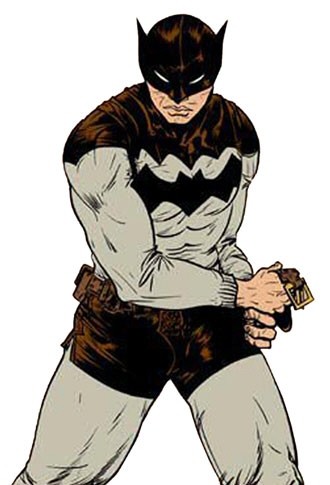| Paul Pope’s Caped Crusader goes retro in Batman Year 100. Courtesy image. |
Paul Pope’s book is an awfully fun read, with his extravagant, festering cartooning style giving Bats a real world to muck through. Pope takes nice liberties with the crimefighter’s costume that, in their low-tech ingenuity, would have made sense back at his 1939 birth: the lace-up combat boots and swimmer-style briefs make the outfit look like something made of actual materials, and in order to scare the hell out of his victims, Batman carries a set of vicious fake teeth that snarl out in every direction.
Weird, though, that Pope chooses to make an issue of the character’s 100-year lifespan (Commissioner Gordon’s grandson digs up photos from different periods in his mysterious career) without inventing an explanation. Is this strange, back-to-basics Bats just one of many men to don the cowl? We assume so, but the writing on that point is awkward.
Easier to understand is the second life of Peter Bagge’s Buddy Bradley, whose ongoing saga in Hate took quite a turn when he moved away from Seattle in 1994. The new Buddy Does Jersey (Fantagraphics) collects this chapter in Buddy’s life, as he trades in slacker cred for a small business of his own and an awfully middle-class domesticity with insecure girlfriend Lisa. I’ve always wondered how many of Bagge’s grunge-era fans stayed with the comic during this phase, as the stories get more autobiographical and less wacky.
The New Adventures of Jesus (Fantagraphics), a collection of old hippie-era comix by Frank Stack, also follows a character beyond his best-known period. Stack’s work, which reframes some Biblical stories in comic everyday terms and imagines new, modern-day adventures for the Son of God, has the endorsement of R. Crumb and others. But like a lot of stuff from the ’60s Underground, its silly gags and cheap abuse of mainstream culture is not for everyone.
Immediately following last month’s column about non-comic work by famous cartoonists, two fantastic art books came out that I have to mention here:
In One Eye (Drawn & Quarterly), Black Hole’s Charles Burns delivers a whole volume without a single example of his revered draftsmanship. Instead, each page is a diptych, jamming two photographs taken in the last few years together into a single composition. Some have obvious thematic connections (empty rooms, ruined walls), and some make visual jokes (a junkie’s torso sprouts a flower where its head should be). But some of the nicest, like “I Won’t Remember Anything You Say,” could almost be mistaken for a single image, albeit one where perspective and sunlight have entered a subtle distortion field — entering, maybe, the narrative worlds Burns concocts in his better-known comics work.
Lyonel Feininger, on the other hand, is more famous for high art than for the whimsical Kin-Der-Kids strip he penned for the Chicago Tribune in the early years of the funny pages. Prestel’s new Lyonel Feininger: Loebermann Collection offers an extensive look at the drawings and prints he made in the years after doing that series (gathering some watercolors as well). The catalogue’s first half is dominated by chunky woodblock prints in which masses of black and white fight for dominance, but the compositions open up in the pen-and-ink work, where hatched-out sailing vessels echo colorful newsprint fantasies that earned the artist a living two decades earlier. Not many artists put their stamp on multiple art forms as successfully as Feininger did — and his son, Andreas, would later add photography to the Feininger legacy.


